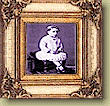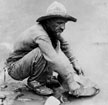

RUMOUR OF DISTURBANCE AT YALE
...continued...
Next morning, about four o'clock, we landed for a short spell of rest, and, clearing away the snow, lit a fire and lay round it for a couple of hours. At the end of that time we picked ourselves up, stiff with cold, and breakfasted, and by half-past seven were under weigh again and paddling up the river, the Indians, to all appearance, as lively and unwearied as if they had slept the whole night through. I cannot say the same for their passenger. It was very cold, a sensation which we both tried in vain to get rid of by taking an occasional turn at the paddles; and the few snatches of short, disturbed sleep we had managed to obtain had left us very much fatigued. The novelty of the situation, too, in my case had worn away, and I confess that the second night of my journey was one of unmitigated discomfort and weariness. Upon the second morning we rested a little longer by our watch-fire, Myhu-pu-pu, the head man of the party, assuring us that we had plenty of time to reach Hope before nightfall. But Myhu-pu-pu was wrong: night fell while we were still some miles below the fort.
About three in the afternoon we had boarded the ‘Enterprise' and learnt that she had been three days in the ice, had only got out of it indeed the previous morning, and that Colonel Moody had not, therefore, been able to reach Hope until that day. We had reason to congratulate ourselves upon our good fortune, as we had only met some floating ice and been nowhere in very serious danger from it, although once or twice we had narrowly escaped being swamped by floating blocks. But as we proceeded we found the river more and more swollen, the ice thicker and in greater quantities, and despite all the efforts of the crew, darkness set in while we were yet some miles short of our destination. On we pushed, however, and I had fallen asleep, when I was suddenly awakened by a sharp crack almost under my head. The canoe had struck a rock in crossing a rapid in the river, at a spot now known as Cornish Bar, but then called Murderer’s Bar, from a murder that had taken place there, and she was stove in unmistakably.
Thanks to the courage and skill of the elder of the crew, we were extricated from our perilous predicament. Leaping on to the rock, against which the full force of the current was driving the canoe, they lifted her off without a moment's hesitation, and the other rowers shooting her ashore, we all jumped out and ran her up upon the snow. Of course everything was wet, ourselves included; but we were too grateful for our narrow escape to heed this trifling inconvenience. Meanwhile the men, whose courage and readiness had preserved us were still upon the rock, the current sweeping by up to their knees and threatening to carry them away. The canoe being hastily repaired and veered down to them by a rope, they too were brought solely ashore. Then arose the question, how were we to be got to Fort Hope that night? It was a serious one, not admitting of a very easy solution.
To get the canoe afloat again was soon found impossible, as she was split fore and aft, and it was ultimately determined to leave two of the Indians in charge of it while the rest of us tried to make the trail, which was known to pass near this spot to the Fort. I have since that night walked that trail, when it was as pretty and pleasant a summer evening's stroll as any one would wish to enjoy; but on this occasion, with two or three feet of snow upon it, and three or four feet more ready to receive us on either side if a false stop was made, that three mile walk to Hope was very hard work while it lasted. It was worse for my companion (Mr. Lewis), for in crossing a river by a fallen tree, which served as a bridge, his foot gave way and he slipped in, drenching his frozen clothes and limbs afresh. Fortunately, however, it was not very deep, and he was fished out, and we reached the Fort without further accident.
Since the time of which I am now writing the old Hudson Bay Fort has been pulled down, and a more commodious one erected in its stead. Then the officer in charge of it had only one chamber to serve for both sitting and bed room; and late at night into this and the presence of Colonel Moody, Captain Grant, Mr. Begbie, and the Hudson Bay Company’s officers, gathered round the fire, we made our way, looking, I dare say, pitiable objects enough. With the ready kindness which I never failed to meet with from the Company's officers in British Columbia, Mr. Ogilvy soon equipped both of us in suits of dry clothes, and seated us before a hot supper.
A subsequent chapter I shall have occasion to speak more fully of "bars;" but as the word will occur frequently in this book, I may here say that all those places where gold is found and worked on a river's bank are called by that name. This term has become the recognised one, and is not mere miners slang; all proclamations referring to gold-extracting, &c., being addressed to the "mining bars" of such and such a district.
Bars are formed simply by a deposit of heaps of detritus at various bends of a river flowing through accumulations of irrupted rock, and between mountains whose sides have been broken down by former great convulsions. The rushing river tears away mass after mass of this rock and gravel, and, carrying on a natural combination of the "sluicing" and "crushing" processes, deposits the gold, with its ever-accompanying black metallic sand and a certain quantity of common earth, at intervals along its banks, carrying most of the lighter sand, &c., out to its mouth, there to form sandbanks and flats. It will be easily understood, therefore, that these bars are formed at every place where there is or has been anything to catch the drift as it comes down. But what is somewhat curious is the very different value of the deposit at various bars, or even parts of the same bar, some being very rich, others very poor, even where they are close together; and this happens not in the vertical section, which would be to some extent intelligible, but at an equal distance under the surface. One part of a bar may 'give out' while another part will be worth working 20 feet deeper.
Thus all ban are formed in the same way, even although the rivers which deposited some of them have long since ceased to flow, or been diverted into other channels, causing what are termed "dry diggings," of which I shall speak hereafter. Very rich bars are often covered with sand, mud, &c., for, in some instances, several hundred feet. In California some of the richest diggings now worked are the beds of old rivers, quite dry, often running in very different directions to those of the present streams and occurring from 100 to 300 feet below what is now the surface of the earth.
The Commissioner was, when I reported myself, rather surprised at the promptitude with which his requisition for troops had been met by the Governor, and perhaps a little embarrassed. His impression now was that the reporter which had reached him at Yale and hurried him hither had been greatly exaggerated, and from the accounts which had since reached him he had the best reason to believe that the feeling of the mining population at Yale and elsewhere had been grossly misrepresented. However, he said that he had decided on proceeding next day to Yale with Mr. Begbie only, leaving Captain Grant and his party of Engineers at Hope; and he desired me to accompany him, so that if, upon his arrival at Yale, the presence of troops should he found necessary, I might return to Hope with orders to that effect; and it was also determined that Mr. Lewis should take the canoe back to Langley as soon as it was repaired, and tell Captain Richards of my arrival and detention.
Home | Contents | Tour | People | Collection | Transportation | Just For Kids! | Team
|
Last updated 31 August 1998. This digital collection was produced under contract to the SchoolNet Digital Collections Program, Industry Canada. Produced by Schoolnet Digital Collections Team. |

|




